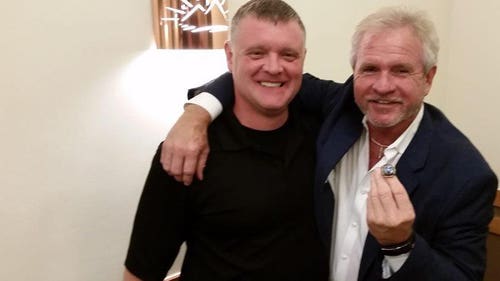
Hall of Fame slugger, Mets icon Ralph Kiner dies at 91

In a perfect world, Ralph Kiner would be behind the mic telling you about Ralph Kiner the player, telling a baseball story as only he could.
Kiner, who died Thursday at his home in Rancho Mirage, Calif., at age 91, remains the only player in baseball history to lead the majors in home runs for six consecutive seasons, which he accomplished with the Pittsburgh Pirates from 1947 through 1952. But Kiner is more commonly associated with a different organization -- the New York Mets, a franchise that didn't exist when Kiner played the final game of his Hall of Fame career in 1955.
Born Oct. 27, 1922 in Santa Rita, NM, Kiner joined the Mets as a broadcaster for their inaugural season in 1962 and remained in their booth for more than 50 years. The television booth at Shea Stadium was named after Kiner. After the Mets moved across the parking lot to Citi Field, the same honor was bestowed upon him there.
For an idiosyncratic franchise that has had to share its legends with other teams -- Tom Seaver and Gary Carter are two -- Kiner was the familiar face who never left. Kiner told captivating yarns about the heroes and characters of yesteryear, while occasionally flubbing the name of a player in that night's lineup. No one minded. It was all part of the charm of a man who once dated Elizabeth Taylor.
Kiner's broadcasting career was so distinguished, and his playing career so relatively short, that many have forgotten how formidable he was in the batter's box. Kiner, in fact, was on track to becoming one of the greatest four or five power hitters in baseball history until a chronic sciatica condition forced him to retire at age 32.
Kiner led the National League in home runs in each of his first seven seasons. He had hit 329 home runs through his age 30 season -- more than Barry Bonds at the same stage of his career and only 37 behind Henry Aaron.
"He was a jewel," Mets Hall of Famer Seaver told The Associated Press.
Kiner finished with 369 homers, 1,015 RBI during his 10-year career, mostly with the Pirates. He made his debut in 1946 and his power quickly became the talk of baseball.

'Kiner's Korner' was a delight for players and fans alike, where stars would join Kiner for postgame chats. Full story
"Kiner's Korner" was already a fixture on the New York Mets' airways when he was inducted into the Hall of Fame in 1975. He was elected with just one vote to spare in his 15th and final year on the Baseball Writers' Association of America ballot.
"I loved going on `Kiner's Korner.' I enjoyed talking baseball with Ralph, especially learning about players from his era," former Mets star Dwight Gooden told The AP. "But what really made it special was every time you went on, you got a $100. For a rookie like me in 1984, a $100 was a big deal."
Kiner, a six-time All-Star, still ranks sixth all-time with a home run every 14.1 at-bats. He averaged more than 100 RBI per season and hit .279 with the Pirates, the Chicago Cubs and Cleveland. When he retired early because of back problems, Kiner was sixth on the career home run list. Several years later, he joined the Mets broadcast crew.
"Kiner's Korner" was a delight for players and fans alike, where stars would join Kiner for postgame chats.
Kiner was known for his malaprops and took them in stride, often laughing about his own comments. He once famously said: "If Casey Stengel were alive today, he'd be spinning in his grave."
Kiner had a stroke about a decade ago that slowed his speech, but remained an occasional part of the Mets' announcing crew. He worked a handful of games last season at Citi Field, his 52th year of calling their games.
Fellow announcers such as Keith Hernandez and Ron Darling always brightened when Kiner was alongside them. Younger fans who were born long after Kiner retired also reveled in his folksy tales.
"As one of baseball's most prolific power hitters for a decade, Ralph struck fear into the hearts of the best pitchers of baseball's Golden Era despite his easygoing nature, disarming humility and movie-star smile," Hall President Jeff Idelson said in a statement.
"His engaging personality and profound knowledge of the game turned him into a living room companion for millions of New York Mets fans who adored his game broadcasts and later `Kiner's Korner' for more than half a century," he said. "He was as comfortable hanging out in Palm Springs with his friend Bob Hope as he was hitting in front of Hank Greenberg at Forbes Field."
As a teen, hanging around the Hollywood Stars in the Pacific Coast League, Kiner shook hands with Babe Ruth and talked ball with Ty Cobb. In high school, he hit a home run off Satchel Paige during a barnstorming tour.
When he got older, Kiner got to play with real Hollywood stars. His pals included Bing Crosby and Frank Sinatra, he squired Taylor and Janet Leigh, he played himself in the 1951 film "Angels in the Outfield," and Kiner would marry tennis star Nancy Chaffee in 1951.
As a rookie, Kiner won the NL homer title with 23, beating Johnny Mize by one. He really broke loose the next year, hitting 51 home runs with 127 RBI while batting .313.
Stuck on poor teams, Kiner never made it to the postseason. He made his mark in All-Star Games, homering in three consecutive.
Kiner connected in the 1950 showcase at Chicago's Comiskey Park, but made more noise with another ball he hit in the game. He hit a long drive to the base of the scoreboard in left-center field and Ted Williams broke his left elbow making the catch, causing him to miss two months.
"Williams always said I ruined his batting stroke, that he could never hit after that," Kiner said. "Yeah, sure. He only hit .388 in `57."
As with Williams, Joe DiMaggio and others of Kiner's era, we'll always wonder what his numbers would have looked like if World War II hadn't intervened. Kiner was away from the game for roughly two-and-a-half years because of his naval service, including time as a pilot in the Pacific.
But despite the time Kiner lost to missions and injuries, his baseball legacy only grew stronger after his final at-bat, thanks to a memorable half-century behind the microphone.
The Associated Press contributed to this report.
Jon Paul Morosi is a National MLB Writer for FOXSports.com. He previously covered baseball for the Detroit Free Press and Seattle Post-Intelligencer. He began his journalism career at the Bay City Times in his native Michigan. Follow him on Twitter.

Pittsburgh Pirate Ralph Kiner featured on a 1950s baseball premium.










